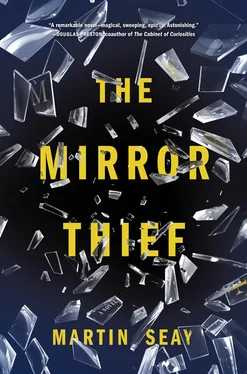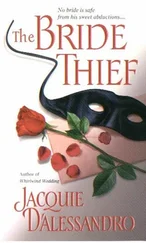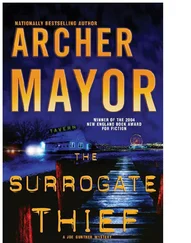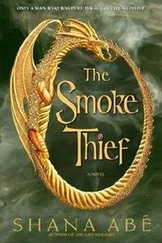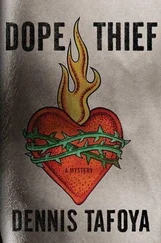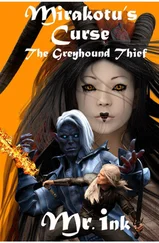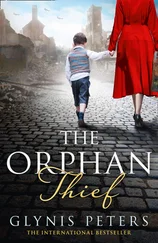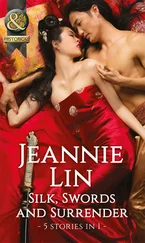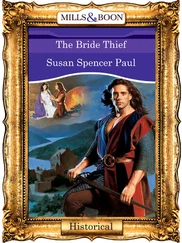Look, he says. You asked me before if I’m the only one Damon sent out here to find Stanley. I told you yes. That’s what I thought at the time. I was wrong. There’s another guy. Local. Tall white guy. Sort of a dirtbag. Calls himself Albedo. You know him?
Her face turns sour. She shakes her head no. She’s telling the truth.
Well, Curtis says, you probably ought to keep an eye out, and steer clear. He wants to make some trouble for you.
Damon sent this guy?
Yeah.
And Damon sent you.
The muscles are tight in her jaw and forehead. There’s way more rage in her face than fear. For a second he thinks she might bite him. He looks away.
Then what the fuck are you telling me about him for, Curtis, if you guys are on the same team?
I want to do this my way, Curtis says. That’s all I want.
She wheels and takes a few steps in silence, then stops again. Staring at the floor. After a while she looks up, past him, at the canvases to his right. Calm now, one hand on her cocked hip. Her posture reminds him of an explorer surveying a treacherous valley, and also of a white girl from Santa Barbara that he dated for a few weeks during his one semester at Cal Lutheran.
Look what happens after 1839, she says.
He tracks her gaze past the bare-breasted Venus he ogled earlier to a couple of later canvasses: a haystack and a field of flowers; a pond glimpsed between trees. Brightly daubed mosaics of color. Curtis looks at them for a second, trying to see what she’s seeing, before his eye slides back across the rusted steel to the Venus. Her piled hair and small white breasts. Her sleepy smile. A ray of late-morning light falls on her from somewhere, and she’s stretching, waking up. Her face half-hidden by her plump raised arm. Her single visible eye watching him with undisguised lust.
1865 and 1880, Veronica’s saying. Corot and Monet. For the first time in four hundred years paintings are flattening out. Chemical photography begins in 1839. All of a sudden the replication of projected images by hand isn’t such a neat trick anymore. The challenge from here is to paint the world the way the mind sees it, not the eye. Not to capture external objects but the act of perception itself. The monocular tradition — the thumb and the eyeball, the picture plane and the camera lens, the illusion of depth — that’s over. Now it’s all about two eyes and a brain in between. Flat retinas and flat canvases. The eye that tricks itself. This is the beginning of modern art.
Curtis shoots her an uneasy glance, but she’s not looking at him. Her eyes are shifting up and down the walls, chasing a thought, following a story written there. She’s talking to herself. It’s impossible to tell how much she knows about him, how much she might have forgotten.
Eventually her attention lands on the Venus, and she flashes a lupine grin. She’s a real creampuff, isn’t she? she says. Even a hundred years before photography, you can tell people are getting bored. Everybody knows the game. You look at her, she looks at you. Trying to get under your skin through your eyeballs. All the old tricks are almost embarrassing. Joshua Reynolds owned a camera obscura that folded into a book.
Curtis and Veronica stand side by side, very still, for a long time. He can almost feel her quick and steady pulse through the sanitized air.
The Venus’s single eye is all pupil, wide and bottomless. The red curtains painted behind her are billowy, frozen, with a pool of dark tangled in their folds. The position she’s in — right elbow above her head — doesn’t look very comfortable. The blond Cupid that tugs at her sash will never untie it. The hand that hides her face will never fall away.
C’mon, Veronica says after a while. Let’s go upstairs. I’ll buy you a doughnut.
The area between the slots and the Doge’s Palace is swarmed by packs of middle-aged white guys wearing golf shirts and identical red-and-white Ace Hardware caps. Some are wheeling luggage, some have the blush of afternoon drunkenness on their cheeks, and all shout back and forth in thick-necked last-day-of-school bonhomie. Curtis and Veronica weave between them, Veronica walking a little in front, alert and unhurried, head sweeping from side to side like a prowling lion’s. Curtis notes the efficient shuttle of her calves and shoulders, and he thinks back to Friday night, watching her at the blackjack table. Her spine tilted like an antenna toward the cards.
They step onto the escalator. Veronica leans on the rubber handrail, looking up at the vast oval canvas on the ceiling: a sturdy blond queen enthroned on a cloud, a levitating angel crowning her from above. Two steps down, his head level with her ribs, Curtis sees that Veronica’s vinyl handbag is two-thirds unzipped, and he remembers the little SIG that she pulled on him last night. It should make him nervous, the fact that she’s carrying, and he wonders why it doesn’t, why he feels relieved. Then, for a sudden sick instant, he’s sure he’s never going to see Stanley Glass alive in this world again. The feeling thins out like smoke, and he follows Veronica into the Great Hall.
On their way toward the fake sky they pass another living statue, or maybe it’s the one Curtis saw last night; he can’t tell. Same whiteface, same robes, same roundlet cap. Ringed by a marble railing topped with crumpled dollar bills. Veronica doesn’t give it a second glance.
At the Krispy Kreme in the Food Court she swaps a voucher for a half-dozen glazed, and they carry them back to the Grand Canal to walk along the railing and listen to the shouts and songs of gondoliers plying the chlorinated water below. How much to ride the boats? Curtis asks.
Like fifteen bucks, I think. In Italy, the real thing would set you back a C-note.
A commedia dell’arte troupe is headed their way — a courtesan and a masked scaramouche harassing what looks like Napoleon — and Veronica makes a swift evasive left onto a bridge, surprising an older couple cuddling over the canal. The permed-and-dyed wife looks at Curtis, then at Veronica, then back at Curtis. Her eyes narrow. The husband — tan, silverhaired, crew sweater around his neck — puts a hand on her back and steers her away.
Whoops, Veronica says. Did we just walk into a Viagra ad?
She takes a doughnut from the box and leans to eat it, her elbows propped on the marble rail. Sugar flakes fall from her fingers, vanishing as they hit the water. There’s a tattoo, a big one, across the base of her spine; Curtis looks at it for a second, looks away, looks back. It’s a tree with seven branches, each labeled with a symbol: sun and moon, male and female, something that looks like a four, or maybe a two, and something that looks like a flat, or a lower-case b. They’re familiar, but Curtis can’t place them. The highest branch, the seventh, is hidden by Veronica’s top. Two figures are under the tree; Curtis can just see their heads over her waistband. The design is inked in black, like an old woodcut. Thinking of his own tats — bird-ball-and-chain on his right deltoid, devil dog on his left pec — and the way they’ve softened over time, he figures hers as eight or nine years old, minimum.
Look at that shit, Veronica says. She’s nodding at the old couple, now strolling the arcade hand in hand. It’s so middlebrow I could shoot somebody. Come to the themed city! Experience the themed culture! Purchase and consume your own reified emotions! Huzzah! Another loveless marriage preserved! I guaran-goddamn-tee you when that guy comes back for COMDEX in November the first thing he’ll do is put on his fuzzy white robe and order himself a nineteen-year-old callgirl for a leisurely half-and-half. He’ll come back to this hotel because he had such a great time here with the wife. He won’t see any contradiction in what he’s doing. And he’ll be right.
Читать дальше
